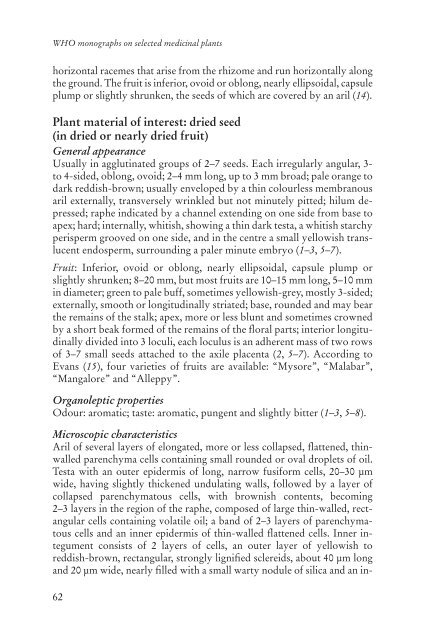WHO monographs on selected medicinal plants - travolekar.ru
WHO monographs on selected medicinal plants - travolekar.ru WHO monographs on selected medicinal plants - travolekar.ru
Semen Cardamomi ner epidermis of flattened cells. Perisperm of thin-walled cells, packed with minute starch grains, 1–6 μm in diameter, and containing 1–7 small prisms of calcium oxalate, about 10–20 μm long. Endosperm, of small thin-walled parenchymatous cells, each filled with a hyaline or granular mass of protein but no starch; embryo, of small thin-walled cells containing aleurone grains; fibrous sclerenchyma and large vessels present in pericarp (2, 3). Powdered plant material Reddish to greyish-brown, characterized by numerous fragments of perisperm cells, each filled with starch granules and containing one or more prisms of calcium oxalate, 10–25 μm long; polyhedral masses of adherent starch granules from perisperm, individual granules, up to 4 μm in diameter; numerous fragments of yellowish to reddish-brown sclereids; occasional particles of epidermal cells, often crossed at right angles by the cells of the collapsed layer (2). General identity tests Macroscopic and microscopic examinations (1–3, 5–8, 14). Purity tests Microbiology Tests for specific microorganisms and microbial contamination limits are as described in the
- Page 20 and 21: WHO monogr
- Page 22 and 23: WHO monogr
- Page 24 and 25: WHO monogr
- Page 26 and 27: WHO monogr
- Page 28 and 29: WHO monogr
- Page 30 and 31: WHO monogr
- Page 32 and 33: WHO monogr
- Page 34 and 35: WHO monogr
- Page 36 and 37: WHO monogr
- Page 38 and 39: Cortex Berberidis Definition Cortex
- Page 40 and 41: WHO monogr
- Page 42 and 43: WHO monogr
- Page 44 and 45: WHO monogr
- Page 46 and 47: WHO monogr
- Page 48 and 49: WHO monogr
- Page 50 and 51: WHO monogr
- Page 52 and 53: WHO monogr
- Page 54 and 55: WHO monogr
- Page 56 and 57: Gummi Boswellii Definition Gummi Bo
- Page 58 and 59: WHO monogr
- Page 60 and 61: WHO monogr
- Page 62 and 63: WHO monogr
- Page 64 and 65: WHO monogr
- Page 66 and 67: WHO monogr
- Page 68 and 69: WHO monogr
- Page 72 and 73: WHO monogr
- Page 74 and 75: WHO monogr
- Page 76 and 77: WHO monogr
- Page 78 and 79: WHO monogr
- Page 80 and 81: WHO monogr
- Page 82 and 83: WHO monogr
- Page 84 and 85: WHO monogr
- Page 86 and 87: WHO monogr
- Page 88 and 89: WHO monogr
- Page 90 and 91: WHO monogr
- Page 92 and 93: WHO monogr
- Page 94 and 95: WHO monogr
- Page 96 and 97: WHO monogr
- Page 98 and 99: WHO monogr
- Page 100 and 101: Folium Cynarae Definition Folium Cy
- Page 102 and 103: WHO monogr
- Page 104 and 105: WHO monogr
- Page 106 and 107: WHO monogr
- Page 108 and 109: WHO monogr
- Page 110 and 111: WHO monogr
- Page 112 and 113: WHO monogr
- Page 114 and 115: WHO monogr
- Page 116 and 117: Cortex Granati Definition Cortex Gr
- Page 118 and 119: WHO monogr
<str<strong>on</strong>g>WHO</str<strong>on</strong>g> <str<strong>on</strong>g>m<strong>on</strong>ographs</str<strong>on</strong>g> <strong>on</strong> <strong>selected</strong> <strong>medicinal</strong> <strong>plants</strong><br />
horiz<strong>on</strong>tal racemes that arise from the rhizome and <strong>ru</strong>n horiz<strong>on</strong>tally al<strong>on</strong>g<br />
the ground. The f<strong>ru</strong>it is inferior, ovoid or obl<strong>on</strong>g, nearly ellipsoidal, capsule<br />
plump or slightly sh<strong>ru</strong>nken, the seeds of which are covered by an aril (14).<br />
Plant material of interest: dried seed<br />
(in dried or nearly dried f<strong>ru</strong>it)<br />
General appearance<br />
Usually in agglutinated groups of 2–7 seeds. Each irregularly angular, 3-<br />
to 4-sided, obl<strong>on</strong>g, ovoid; 2–4 mm l<strong>on</strong>g, up to 3 mm broad; pale orange to<br />
dark reddish-brown; usually enveloped by a thin colourless membranous<br />
aril externally, transversely wrinkled but not minutely pitted; hilum depressed;<br />
raphe indicated by a channel extending <strong>on</strong> <strong>on</strong>e side from base to<br />
apex; hard; internally, whitish, showing a thin dark testa, a whitish starchy<br />
perisperm grooved <strong>on</strong> <strong>on</strong>e side, and in the centre a small yellowish translucent<br />
endosperm, surrounding a paler minute embryo (1–3, 5–7).<br />
F<strong>ru</strong>it: Inferior, ovoid or obl<strong>on</strong>g, nearly ellipsoidal, capsule plump or<br />
slightly sh<strong>ru</strong>nken; 8–20 mm, but most f<strong>ru</strong>its are 10–15 mm l<strong>on</strong>g, 5–10 mm<br />
in diameter; green to pale buff, sometimes yellowish-grey, mostly 3-sided;<br />
externally, smooth or l<strong>on</strong>gitudinally striated; base, rounded and may bear<br />
the remains of the stalk; apex, more or less blunt and sometimes crowned<br />
by a short beak formed of the remains of the floral parts; interior l<strong>on</strong>gitudinally<br />
divided into 3 loculi, each loculus is an adherent mass of two rows<br />
of 3–7 small seeds attached to the axile placenta (2, 5–7). According to<br />
Evans (15), four varieties of f<strong>ru</strong>its are available: “Mysore”, “Malabar”,<br />
“Mangalore” and “Alleppy”.<br />
Organoleptic properties<br />
Odour: aromatic; taste: aromatic, pungent and slightly bitter (1–3, 5–8).<br />
Microscopic characteristics<br />
Aril of several layers of el<strong>on</strong>gated, more or less collapsed, flattened, thinwalled<br />
parenchyma cells c<strong>on</strong>taining small rounded or oval droplets of oil.<br />
Testa with an outer epidermis of l<strong>on</strong>g, narrow fusiform cells, 20–30 μm<br />
wide, having slightly thickened undulating walls, followed by a layer of<br />
collapsed parenchymatous cells, with brownish c<strong>on</strong>tents, becoming<br />
2–3 layers in the regi<strong>on</strong> of the raphe, composed of large thin-walled, rectangular<br />
cells c<strong>on</strong>taining volatile oil; a band of 2–3 layers of parenchymatous<br />
cells and an inner epidermis of thin-walled flattened cells. Inner integument<br />
c<strong>on</strong>sists of 2 layers of cells, an outer layer of yellowish to<br />
reddish-brown, rectangular, str<strong>on</strong>gly lignified sclereids, about 40 μm l<strong>on</strong>g<br />
and 20 μm wide, nearly filled with a small warty nodule of silica and an in-<br />
62



